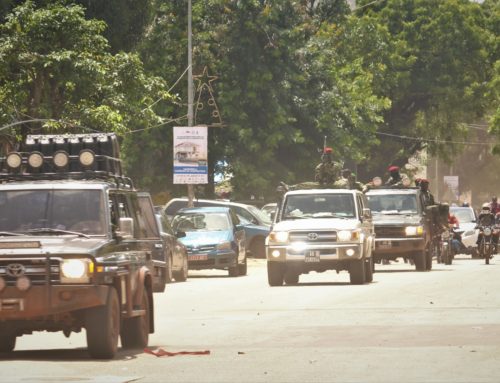By: Craig Collins
In the first installment of this two-part article we examined the notion that any future without globalization must be an improvement. But globalization and growth only constitute capitalism’s expansionist phase, powered by abundant fossil fuels. As energy becomes scarce, boom turns to bust. But profit-hungry capitalism doesn’t die; it morphs into its zombie-like, undead phase.
Growth-less capitalism turns catabolic. The word catabolism is used in biology to refer to the condition whereby a living thing feeds on itself. Thus, catabolic capitalism is a self-cannibalizing system whose insatiable hunger for profit can only be fed by consuming the society that sustains it.[1] As it rampages down the road to ruin, this system gorges itself on one self-inflicted disaster after another. Unless we bring it down, catabolic capitalism will leave its survivors rummaging through the toxic rubble left behind.
Capitalism is adept at exploiting human weaknesses, especially greed and fear. During the period of rapid expansion, greed provides the most powerful incentive for investors, while fear comes in a distant second. Investors are encouraged to take big risks and go into debt in the hope of scoring windfall profits. Speculative bubbles grow rapidly as people try to make it rich on the next big deal. But when boom turns to bust, fear takes the drivers seat. In these troubled times, the most profitable ventures capitalize on insecurity, desperation and scarcity.
In the era of fossil fuel abundance, catabolic capitalists worked the dim back alleys of the growth economy. But, as the productive sector atrophies and the financial sector seizes up, this parasitic sector emerges from the shadows and proliferates rapidly. It thrives off anxiety and hoarding; corruption and crime; conflict and collapse. Catabolic capitalism profits by confiscating and selling off the stranded assets of the bankrupt productive and public sectors; dodging or dismantling legalities and regulations while pocketing taxpayer subsidies; hoarding scarce resources and peddling arms to those fighting over them; and preying upon the utter desperation of people who can no longer find gainful employment elsewhere.
This looming catabolic future will transform the Green New Deals proposed by eco-optimists like Al Gore, Lester Brown and Jeremy Rifkin into ecotopian pipe dreams…unless we exorcise capitalism’s profit possession from the economy.[2] Instead of investing society’s remaining resources into a sustainable recovery and renewal, catabolic capitalism will eat away at society like a cancerous tumor. A malignant alliance of parasitic profiteers, resource cartels and weapons merchants will infect the body politic and poison any effort to prevent them from ransacking the economy and the Earth. If society succumbs to their all-consuming thirst for profit, life will become a dismal affair for everyone but them.
However, at the risk of sounding over-optimistic, the approaching period of catabolic collapse presents some strategic opportunities to those who would like to rid the world of this system as soon as possible. The end of growth seriously erodes the legitimacy of capitalism by undermining its capacity to meet the needs of everyday life. For the time being, most people continue to believe, or hope, that the lethargy infecting the global economy will pass. It’s too frightening to face the fact that we’re scraping the bottom of the oil barrel and that economic contraction, financial mayhem and climate chaos are becoming the new normal.
But denial is often followed by anger. And if that anger is organized and channeled into the political muscle needed to break the grip of catabolic capitalism over our lives, we could begin to build a viable future that puts people and the planet ahead of profit. Granted, this is an enormous “IF.” But before we decide that resistance is futile, it’s important to realize that the converging energy, economic and ecological disasters bearing down on us all have the potential to turn people against catabolic capitalism and toward a more just, planet-friendly future.
For example, in the near future, energy scarcity and economic contraction may manifest themselves as a paralyzing financial meltdown. Interest-based banking cannot handle economic contraction. Without perpetual growth, businesses, consumers, students, homeowners, governments and banks (who constantly borrow from each other) cannot pay-off their debts with interest. If default goes viral, the banking system goes down.[3]
So far, governments (taxpayers) have reluctantly contained this crisis by bailing out failing banks. But bailouts rob governments and taxpayers of revenue; drive them deeper into debt and retard growth even further. In essence, we’re doubling-down on a sure loser just to put off the day of reckoning, while parasitic banks grow larger and continue robbing us with impunity. Soon, what is currently a slow motion financial emergency may lead to a sudden, cascading paralysis of daily life.[4]
When the banking system finally implodes, credit freezes, financial assets vaporize, currency values fluctuate wildly, trade shuts down and governments impose draconian measures to maintain their authority. Few Americans have any experience with this kind of systemic seizure. They assume there will always be food in the supermarkets, gas in the pumps, money in the ATMs, electricity in the power lines and medicine in the pharmacies and hospitals.
How people respond to this systemic disintegration will be pivotal. Who will be blamed? What “solutions” will gain support? Who will people listen to, trust and follow in this time of extreme hardship, insecurity and unrest? Naomi Klein’s Shock Doctrine clearly exposes how those in power can exploit the trauma caused by major catastrophes to rally support for their own disastrous agenda (like invading Iraq after 9-11 or expelling the Black community from New Orleans after Katrina). Each time they succeed, life becomes more miserable for everyone but them.
However, crisis and calamity can backfire on established authorities. During a financial meltdown, government officials find it difficult to retain public confidence; people blame them for running the economy into the ditch and suspect that their pseudo-solutions are actually self-serving schemes designed to keep themselves on top. Consequently, this crippling crisis could serve as a powerful wake-up call and a potential turning point if those who want to scrap catabolic capitalism are prepared to make the most of it. But here come the big “IFs”…
If Green community organizers and social movements initiate non-profit forms of socially responsible banking, production and exchange that help people survive systemic breakdowns, they will earn valuable public approval and respect. If they help organize community farms, kitchens, health clinics and neighborhood security they will gain further cooperation and support. And if they can rally people to protect their savings and pensions and prevent foreclosures, evictions, lay-offs and workplace shutdowns, then popular resistance to catabolic capitalism will grow dramatically. To nurture the transition toward a thriving, just, ecologically stable society, all of these struggles must be interwoven and infused with an inspirational vision of how much better life could be if we freed ourselves from this dysfunctional, profit-obsessed system once and for all.
Of course, a financial meltdown is just one symptom of our dysfunctional society. To overcome catabolic capitalism, movement activists will have to anticipate and help people respond to multiple crises while organizing them to recognize and root out their sources. For instance, climate chaos alone will impose many hardships, from extreme droughts, water scarcity, farm failures and food shortages to forest fires and floods, rising sea levels, mega-storms and acidified oceans. Movement organizers must help people anticipate, adapt to, and survive these hardships—but social movements cannot stop there. They must help people mount the kind of political resistance that can strip the fossil fuel industry of its power and leverage their own growing influence to demand that society’s remaining resources be re-directed toward a Green transition.
Power will be decisive in the unfolding struggle over the future of our species and the planet; and those that benefit from the status quo are bent on holding on to it. To do this they must encourage apathy and denial, play upon our insecurities, and manipulate our conflicting loyalties to keep us passive, divided and under control. When denial and distraction fail, they foster hopelessness and despair. If despair turns to anger, they manipulate our prejudices and fears to turn us against each other. If we resist all attempts to keep us apathetic, distracted and divided, they seldom hesitate to use all the methods at their disposal to keep themselves on top, including intimidation, coercion and brute force.
Nevertheless, the mounting crises of daily life are reanimating grassroots resistance around the world and eroding the established centers of power and control. Much has changed in a short time. Not long ago, the cosmopolitan corporate illuminati had most of the world, including themselves, convinced that globalization was the inevitable and incontestable wave of the future. But today it sinks beneath the mire of its own contradictions.
This historic reversal from growth to contraction must be recognized and named for what it is: the end times for the Age of Fossil Fuels. It portends the disintegration of the modern world economy and the demise of all the structures of international economic integration and power, from transnational corporations to global financial institutions like the IMF, the World Bank and the World Trade Organization. The first casualty in this unfolding crisis may be the European Union, but China’s energy-short, export-dependent, politically rigid society is rushing toward implosion as well.[5]
Here in the United States, the struggle for a Green transition will face some uniquely daunting problems. America’s superpower status and its carefully nurtured self-image as the defender of democracy, liberty and the freedom to shop-til’-you-drop, will be hard for people to question or reconsider. Bush senior expressed it clearly when he informed climate negotiators in Rio that “the American way of life is not up for negotiation.” The subtext here is obvious: if we want to keep burning fossil fuels, we will; and if we need more oil, we’ll take it. Who’s gonna stop us? President Trump is only doubling down on this deluded, self-righteous sentiment.
This sanctimonious type of patriotism runs so deep in our political culture that any discussion of ecological or economic limits is the kiss of death for American politicians. No president since Jimmy Carter has dared to bring it up. This prevailing attitude makes it easy for the petro-military complex to get its way in Washington. Instead of building a renewable energy infrastructure and reducing fossil fuel use, politicians follow the path of least resistance. This means subsidizing the ecologically disastrous extraction of dirty, low-grade fossil fuels and escalating on our military capacity to dominate the planet’s dwindling petroleum reserves.
The tremendous sacrifice of lives, money and resources that feeds the Pentagon’s 1,000-base global arsenal imposes an enormous weight on the American people.[6] This oppressive burden creates the potential to provoke widespread resistance to empire. Eventually, of course, history will vanquish this empire like all those before it. But time is critical. Every year the US wastes priceless lives and billions of dollars protecting the investments of oil companies and transnational corporations. If American troops protected our own borders instead, like most countries, the immeasurable savings could put people to work improving the quality of life for everyone.
But for now, the petro-military colossus and the self-satisfied attitude of entitlement and superiority that endorses it, remains largely unchallenged. This giant military machine provides a deadly temptation for avid patriots to reassert American superiority by following bellicose politicians and generals to war over dwindling resources. Unless this changes, the United States may squander precious time, lives and resources battling its way to the bottom of the barrel. After a series of debilitating, self-defeating resource wars, America may find itself way behind as the rest of the world struggles toward a peaceful, ecologically sustainable future.
Looking into the abyss of industrial collapse is deeply unnerving. Can eight or nine billion people survive the Earth-altering, economy-crashing consequences of burning through our vanishing stock of fossil fuels? Can we cope with climate chaos, economic mayhem and scarcities of food, water and fuel?
These challenges are monumental. They will force us to question our identities, our values and our loyalties like no other experience in history. Who are we? Are we, first and foremost, human beings struggling to raise our families, strengthen our communities, and coexist with the other inhabitants of Earth? Or do our primary loyalties belong to our nation, our culture, our race, our ideology, or our religion? Can we retain our other loyalties but put the survival of our species and our planet first, or will we allow ourselves to become hopelessly divided along national, cultural, racial, religious or party lines?
Today, the emerging global movement toward a sustainable future is so embryonic it hasn’t even taken a name. I prefer to call it the Green Resistance Movement because “GRM” is such a useful acronym. Activists can think of it as GRMinating a new way of life, or waging GRM warfare against the old one. Meanwhile, the less confrontational side of the movement can use GRM to stand for Green Revival Movement or even renaissance, renewal, recovery, or resilience.
Whatever we call it, this loose, eclectic movement is alive and growing. It constitutes the general expression of hundreds of smaller movements, each a product of its own particular history and most pressing concerns.[7] It includes an amazing amalgam of dedicated activists, from alternative energy innovators, climate scientists, ecologists and organic growers to inner city environmental justice advocates, landless peasants, students, labor organizers, farm workers and indigenous communities resisting resource exploitation and ecological destruction. It connects battles against clear-cutting, water privatization, mega damns, fracking, mountaintop removal, genetically modified crops and pesticide poisoning with fights for workers’ rights, labor justice, debt slavery and corporate reform. It links campaigns to prevent climate chaos and adopt renewable energy with demonstrations against war, militarism, repression and human rights abuses. Despite their disparate starting points, these multiple micro-movements have begun converging, like tributaries into a river washing away the eroding edifice of global capitalism.
As it grows, this fledgling movement will have to fight for its life every step of the way. To GRMinate a culture of resistance and seize the latent opportunities in each new crisis it will have to be practical, playful, resilient, nurturing, brave and visionary. Without corporate sponsorship like the Tea Party or the alt-Right, GRMs will need to invent creative ways to subvert, mock, out maneuver and overcome malevolent media, usurious banksters, heartless capitalists, venal politicians and their iron-fisted apparatus of repression.
The eventual outcome of this great contraction is up for grabs. Will we overcome denial and despair; kick our addiction to petroleum; and pull together to break the grip of corporate power over our lives? Can we foster genuine democracy, harness renewable energy, reweave our communities, re-learn forgotten skills, and heal the wounds we’ve inflicted on the Earth? Or will fear and prejudice drive us into hostile camps, fighting over the dwindling resources of a degraded planet? Our capacity to GRMinate a Green Resistance Movement will determine whether we descend from the pinnacle of industrial civilization walking arm-in-arm, or get dragged off the ledge by parasitic profiteers and power-hungry tyrants.
Craig Collins Ph.D. is the author of Toxic Loopholes (Cambridge University Press), which examines America’s dysfunctional system of environmental protection. He teaches political science and environmental law at California State University East Bay and was a founding member of the Green Party of California. His forthcoming books: Marx & Mother Nature and Rising From the Ruins: Catabolic Capitalism & Green Resistance reformulate Marx’s theory of history & social change and examine the emerging struggle to replace catabolic capitalism with a thriving, just, ecologically resilient society.
Image: James Ensor, Squelette arrêtant masques (1891), private collection.
[1] The term “catabolic capitalism” used here is somewhat different from the theory of catabolic collapse developed by John Michael Greer. Greer looks at the demise of all civilizations (capitalist and non-capitalist) as a catabolic process. How Civilizations Fall: A Theory of Catabolic Collapse <www.dylan.org.uk/greer_on_collapse.pdf>
[2] Rifkin, Jeremy. The Third Industrial Revolution (Palgrave) 2011; Gore, Al. Earth In the Balance. (Houghton Mifflin) 1992; Gore, Al. Our Choice: A Plan to Solve the Climate Crisis (Rodale Books), 2009; Brown, Lester. Plan B 4.0: Mobilizing to Save Civilization (WW Norton & Co.) 2009.
[3] Banks’ retained earnings and shareholder capital only amount to 2-9% of their loan portfolio, so it doesn’t take much of a loss to put them under.
[4] Korowicz, David. Trade Off: Financial System Supply-Chain Cross Contagion–A Study In Global Systemic Collapse http://www.feasta.org/2012/06/17/trade-off-financial-system-supply-chain-cross-contagion-a-study-in-global-systemic-collapse/
[5] Wong, Edward. “China’s Growth Slows, and Its Political Model Shows Limits” New York Times (May 10, 2012) http://www.nytimes.com/2012/05/11/world/asia/chinas-unique-economic-model-gets-new-scrutiny.html?pagewanted=all
[6] This is a rough estimate. For a detailed discussion of impossibility of getting an accurate tally of US military bases around the world see: Johnson, Chalmers. The Sorrows of Empire: Militarism, Secrecy, and the End of the Republic. (Metropolitan Books) 2004; and Turse, Nick. “Empire of Bases,” Asia Times (Jan. 12, 2011) http://www.atimes.com/atimes/South_Asia/MA12Df01.html
[7] Movement of Movements. (Parts 1 & 2) 2004 & 2018; and Hawken, Paul. Blessed Unrest (Viking) 2007.










Leave A Comment